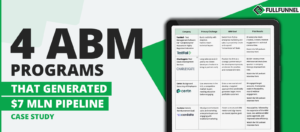Bonus workbook: B2B buyer journey template (click to download)
In this article, I’m going to show you why the root reason behind miserable results of B2B marketing is the fundamental mismatch between the way companies market and sell, and the way that modern B2B buyers buy.
I’ll then guide you through the steps to create a buyer-centric approach that we use to land qualified, in-the-market, five and six-figure opportunities with 20%+ of target accounts.
You’ll discover:
- Seven stages of a modern buyer journey (with a real, 47-step example)
- Step-by-step process to map your buyer journey (including 45 questions to ask in customer research)
- A guide to identifying the priority actions and content to influence buyers at each stage of the buying process
After reading this article, you will finally understand why so many B2B marketing programs fail, and how to start marketing the way your best customers actually buy.
Table of Contents
ToggleHow most B2B companies market, and why it doesn’t work
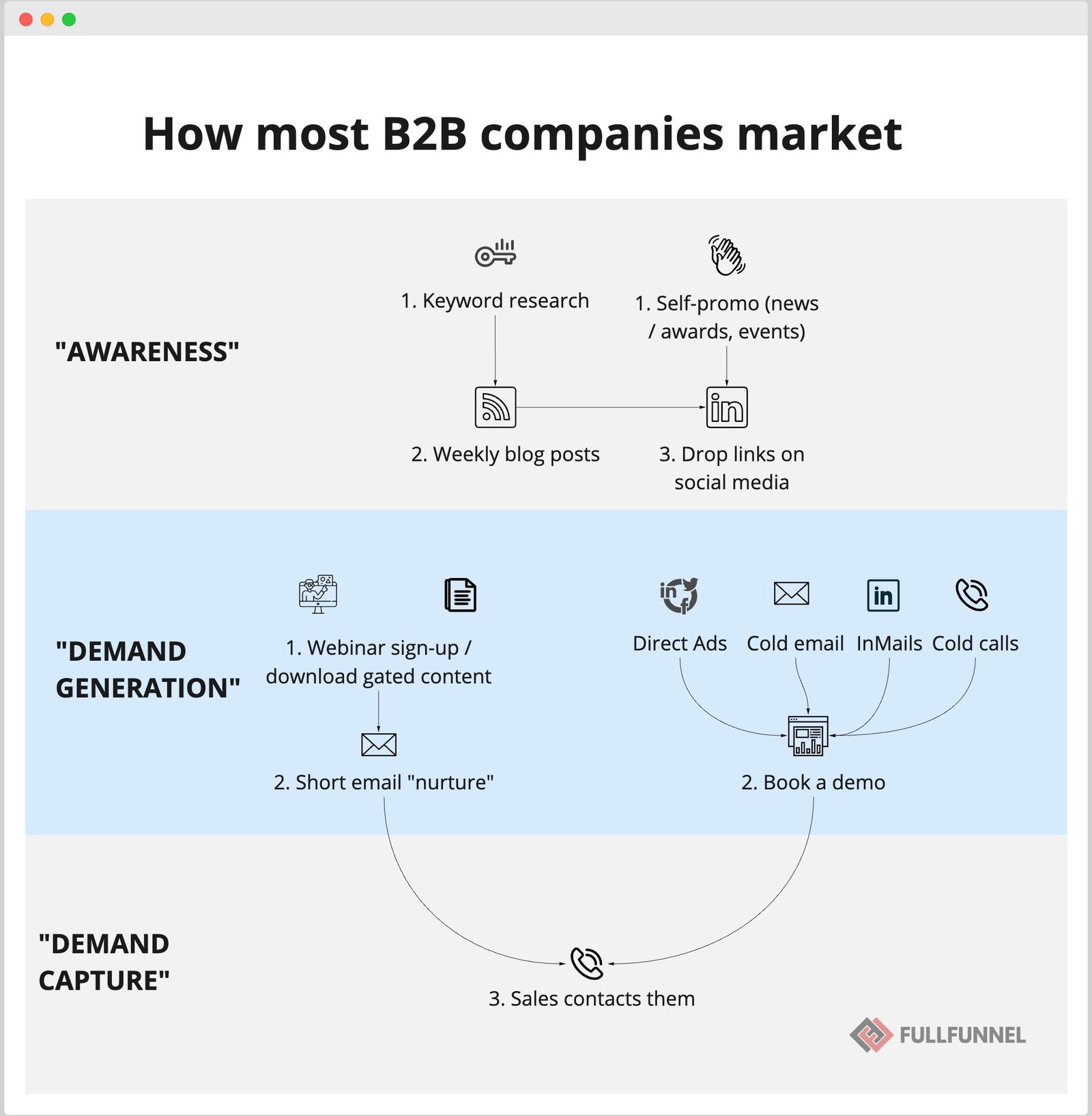
1. They promote gated content and webinars, then send leads to sales
Why it doesn’t work:
A download or a webinar registration is NOT a buying intent.
Six figure buyers don’t download an e-book, and get “nurtured” into an opportunity with a 5-email sequence—nor do they “hop on a 15-min call” just because a random rep sent them a generic cold email.
They start buying when the issues or opportunities become a strategic priority, ask their trusted network for recommendations, and buy from people they know, like and trust.
2. They drive cold, low-intent traffic, via ads or emails, to a landing page promoting a demo or a trial
Why it doesn’t work:
If you’re running ads on social media, or sending emails to your list (or a cold audience), you are effectively wasting 97% of your budget.
Why?
These are not intent channels, and only a small percent of your market is actively buying.
And even when you do target buyers in the market right now +only focus on capturing the existing demand), you will:
- Come too late into the buying journey, after your competitors have been positioning themselves and influencing the buying committee and their purchase criteria
- Be perceived as one of many, a commodity
- Have low win rate, and high cost of sales. In practice, most of the deals closed at this stage are smaller in size.
3. They promote content and company news on social media
Why it doesn’t work:
The vast majority of B2B brands use social to drop links to their website, promote events, and publish company news that delivers 0 value to buyers. The engagement and reach of these posts is extremely low, and impact even lower.
You need to reach buyers where they are, and share native, stand-out content they will share in places you cannot get to.
4. They publish weekly SEO blog, and a quarterly white paper
Why it doesn’t work:
The majority of B2B content driven by keyword research is boring, superficial, me-too content that doesn’t have any influence on the target buyers. The rest of B2B content is usually salesy content about product features, masking as educational.
Your buyers don’t need MORE content. They need better, stand-out content that answers specific questions and objections they have as they move through the buying process.
What all these approaches have in common
Here is what all of these outdated playbooks have in common:
They ignore the reality of the modern buying process. They are based on how you want to sell, not on the way your customers buy.
Now, let’s look at how modern B2B buyers actually buy, and how companies can influence the buying journey.
[cboxarea id=”cbox-Xl24t1Q5y2p8mA4x”]
Buyer journey stages (with a real, 47-step example)

1. AWARENESS
Buyer journey: triggers, challenges, opportunities
The buyer’s journey does NOT start with a visit to your website or a Google search.
Buyers go through a long period of doing their best to deal with the issues. Until a triggering event shifts their priorities to specific challenges or opportunities.
Example of the triggering event:
- Solution: a fintech solution to hedge risks against currency volatility.
- The triggering event: For the second quarter in a row, the CFO of a manufacturing company discovers a loss due to fluctuating exchange rates.
- The start of the buying journey: She starts asking around and looking for ways to deal with currency fluctuation. An alumnus from her MBA mentions hedging as a potential solution.
- Other example triggers: missing forecasts, new suppliers or customers using different currencies, events or peers mention the hedging option
Helping your buyers navigate this stage is the role of top-of-funnel awareness.
Example activities: Thought leadership, frequent, native content and engagement on target channels and communities, speaking at podcasts or partner events.
The key is to identify the core goals, issues and triggers of your ideal buyers, so that your content is relevant for the buyers at this stage.
Real example of the buyer journey at the category consideration stage:
- A marketer sees a comment on Vlad’s LinkedIn post, reads it, and likes it
- Vlad send an invitation to connect to the marketer, thanking him for the support
- He accepts the invitation to connect
- Vlad thanks him for the connection, and mentions our free Trenches – B2B marketing community
- The marketer joins, but keeps lurking
- Occasionally, he shares FullFunnel.io posts on his company’s Slack channel
- Andrei announces a partner webinar with a MarTech vendor used by the marketer’s team
2. DEMAND GENERATION (CATEGORY CONSIDERATION)
Buyer journey: triggers, challenges, opportunities, category consideration
At this stage, the buyers are evaluating different approaches and categories.
For example, let’s say that a CMO is researching the best ways to market to the enterprise segment. They may consider enterprise lead generation, account-based marketing and demand generation.
After settling on a specific approach, they still need to decide how they will implement it. They may consider different categories. For example, to implement an ABM program, they may consider ABM technology platforms, ABM training or consulting, or outsourcing this program to an agency.
When it comes to demand generation strategy, it’s important to understand this:
You cannot drive demand for your solution, without buyers’ consensus on the category.
You do this by educating buyers about the benefits of the approach and category.
For example, by sharing case studies, guides or webinars about the general approach, you can help buyers understand the benefits (and evaluate if the approach and category are the right fit for their situation and problem they are looking to solve).
Real example of the buyer journey at the category consideration stage:
- Marketer joins the webinar to learn about ABM (account-based marketing)
- After the webinar, Vlad sends him a video message and shares a content hub with the slides, a couple of case studies and our ABM framework
- The marketer shares the content hub with his CMO
- The CMO checks out our case study
- After seeing this in the content analytics, Vlad connects to the CMO, and asks her what she thought about it
- The CMO remembers the case study, but decides it’s not the right time and ignores Vlad’s outreach
- She starts seeing Vlad’s posts on her feed but almost never engages
Internal trigger:
- The CMO gets critical feedback about the ROI of their programs, and ambitious KPIs for the next year
- She sees a post about our summit, and asks her marketer to join and collect ideas for the next year
- The marketer attends our session about full-funnel marketing planning
- He shares a screenshot of the slide with our framework with his CMO
[cboxarea id=”cbox-Xl24t1Q5y2p8mA4x”]
3. DEMAND GENERATION (SOLUTION)
Buyer journey: vendor discovery & evaluation
Once the buyers settle on a specific category, they will start researching, evaluating and comparing the different vendors. They may ask their colleagues, peers or niche community members, and check sites like G2 or Clutch.
In their marketing programs, many B2B companies make the mistake of skipping the previous two stages of the buying process, and focus most of their efforts on buyers who are at this stage (buyers actively searching for vendors in your category).
Why is that a mistake?
Because, while researching their problems (awareness stage) and different solution approaches and categories (category consideration stage), the buyers are already discovering the vendors who are actively educating them during the earlier stages. These vendors have a unique advantage, because they have the chance to frame buyer’s thinking about the category and influence the purchase criteria.
For example, while educating our buyers about the Account-Based Marketing (ABM) approach, we’ll point out things that are often missed in ABM programs (such as warm-up programs, account research, pilot abm campaigns…). If the buyers looking for ABM training and consulting understand and agree with our point of view on ABM, we will have a unique advantage, because many vendors miss these elements.
Therefore, as you’re educating the buyers about the general approach and category through case studies, guides or webinars, make sure to:
- Educate them about the importance of your unique approach, features or other USPs that make you different from other vendors
- Embed native examples of your solution (screenshots, client success stories etc.) to create interest for your specific solution
Furthermore, by regularly sharing stand-out, educational content about industry challenges, opportunities, and the approach and category, you are becoming known in your industry—or in other words, known by the people your buyers ask for a recommendation.
Real example of the buyer journey at the vendor discovery and evaluation stage:
- After seeing our framework shared by her marketer (and seeing our content and brand several times in the past), the CMO decides to check out our website, and recognizes one of our clients
- She reaches out and gets a positive recommendation
- She asks the marketer to book a call with us
4. DEMAND CAPTURE
Buyer journey: vendor vetting, driving internal consensus
Some buyers are ready to buy, and, if you’ve done a good job, will reach out to you. Your first job is to make this as easy as possible, by removing friction from your marketing and sales funnel.
Common sources of friction in the marketing process:
- Hiding the product price on the pricing or demo request page
- Unnecessarily long forms (where data enrichment can do the job)
- Vague, broad copy that doesn’t describe what product does
- No clear differentiation (this is bad for you, but it’s also a source of friction, as it makes it more difficult for the buyer to make a choice)
- Lack of ungated product tour, videos and detailed description of key features
- Lack of segmentation and providing specific information for the segments (on the website, emails…)
- Landing page that doesn’t deliver on the promise you made in the ad copy and / or headline
- Lack of alignment with sales (the teams should be aligned on qualification criteria, messaging, lead handover process…)
- Sending low-intent “leads” to sales (e.g. email subscribers, companies that visit the website, click the ads, webinar attendees or people who downloaded gated content)
- Lack of a clear leads handoff process
- Lack of buyer enablement content to help buyers find the answers to their questions and make the right decisions
- Lack of relevant and detailed case studies that help buyers understand the steps, people involved, timing and milestones, speed of ROI…
Sales:
- Lack of personalization in outreach
- Demo request that doesn’t redirect to a calendar, so a prospect needs to wait for someone from the vendor’s team to reach out to them
- Demo that’s actually a qualification call, where an SDR asks a bunch of qualification questions, before booking a call with an AE (who then asks many of the same questions)—instead of discovering the buyer’s needs, showing how the product can help, and answering their questions
- Salespeople that don’t have enough product knowledge to answer buyers questions quickly
- Lack of follow up
Real example of the buyer journey at the vendor vetting / demand capture stage:
- The marketer visits our website to book a call with us
- He starts filling out our discovery call form but gets interrupted and doesn’t submit the form
- Through our IP tracking software (we use Albacross), we see that someone from that company started to fill out the form
- Vlad reaches out to the marketer, asking about it, and offering to help
- The marketer mentions he wanted to book a call with us, but got distracted
- I send him a link to the calendar, he books the call
- After the discovery call, I share the summary of the call and a content hub with the proposal for a short discovery engagement, along with a few key pieces of buyer enablement content
- The marketer presents our proposal, but gets a critical question about ROI he doesn’t know how to answer
- He stops responding to our follow-up
5.ACTIVATION
Buyer journey: driving consensus, and getting approvals
Demand generation activities in the earlier stages create a pool of engaged accounts interested in your solution. Some of the buyers are ready to buy, and will reach out to you.
Others may simply not be ready to purchase and implement a solution yet. Or they may run into a blocking point, as illustrated in the example above (when the marketer didn’t know how to answer critical questions from the CMO, and has stopped responding).
Here is what you can do at this stage, to accelerate the buyer journey.
Leverage different sources of engagement & intent data to identify accounts with intent (e.g. stale deals in your pipeline, accounts actively visiting key pages of your website, accounts actively checking out you and your competitors on directories such as G2…).
Note, not every engagement represents a buying intent, nor is every account a good fit. Only if the accounts meet the engagement threshold and pass qualification criteria, you can add them to your ABM programs, to try to proactively activate them.
Real example of the buyer journey at the consensus and approval stage / demand capture stage:
- After the marketer has gone silent, Andrei engages with the CMO’s recent post, and follows up with a LinkedIn message, inviting her to our podcast. She agrees to join
- During the pre-production interview, he asks her about their challenges and priorities (to get the business context), and agrees with her on the topics to discuss during the main podcast interview.
- After the main interview, Andrei reminds the CMO on how our proposal can help solve the challenges and help with priorities she shared in the pre-production interview. She shares her concerns and critical questions
- We agree that we’ll help the marketer work out the business case
- With the marketer, we create the business case, and share a relevant case study and references
- The CMO reviews the materials, and asks the marketer to check two more references
- After receiving positive feedback on reference checks, the CMO books a call with Vlad, and asks a few more critical questions
- We agree to start with a simple, low-ticket alignment and planning sprint
- During the sprint, we help drive internal consensus and alignment, and get the buy-in for a marketing plan to reach their new KPIs
- The CMO decides to hire us to guide the implementation, and gets an approval for the first quarter
6. CUSTOMER SUCCESS & ADVOCACY
Buyer journey: implementation, change management
At this stage, the buyers (now customers) are working on implementation, onboarding and training team members and refining processes to get the most out of the acquired solution.
At this stage, customers rely on the documentation and training materials, and work with the customer success (CS) team.
However, for many B2B companies, customer success (CS) is a passive process that is limited to:
- Answering the tickets
- Interacting via live chat
- Running the training and onboarding calls
And while a key goal of the CS team should be to support customers in successfully implementing the solution, they are a key part of revenue operations.
Here is how to align CS with marketing and sales:
1. Satisfaction tracking and churn prevention
Most B2B companies assume that, when it comes to customer satisfaction, “no news is good news”.
But, the truth is that only 1 out of 26 unhappy customers complain, the rest simply churn.
Timely interactions, and proactively helping the customer’s team get the most value out of the solution, can help identify and prevent churn.
2. Advocacy opportunities
Word of mouth is the KEY influence in making B2B purchase decisions. The good news is that 83% of the customers are open to providing a referral… if you know when and how to ask for it.
The key steps:
- Choose a ‘peak’ moment (e.g. after a successful implementation, when the customer has expressed satisfaction)
- Schedule a debriefing interview with the customer
- Before the interview, research target accounts your customer is connected to (so you’ll make the next step easier)
- Ask if you can record the interview and if you can use the insights within a case study or a testimonial
- Make it super-easy for your customer to provide you a referral (e.g. for the connections you identified, ask if they’d be ok if you emailed the connection, with the customer in CC, mentioning the successful implementation)
Next to referrals, you can drive customer advocacy through case studies, by involving customers in events, reference calls, asking them to provide recommendations on review websites, etc.
3. Customer insights
One of the key success factors in rolling out a buyer-centric GTM strategy and marketing programs is customer insight. Unfortunately, many B2B companies skip this step and base their decisions on their interpretation and assumptions about the buying journey.
Interviews and insight collection should become an integral part of the sales, marketing and CS process. The revenue teams need to work together to collect customers insights at key moments:
- After the successful sale, interview your customer about the buying triggers, challenges and goals, the buying committee and their purchase criteria, and why they chose you over competitors
- After the successful implementation, interview them about the value, benefits and what they liked (and could still be improved) about the product, implementation and the rest of the customer experience
- During regular check-ins with the CS and account management team, ask about impact, any issues or missing elements, and their next steps and key initiatives
- During customer and industry events, you can have your team collect information that is missing, or is not up to date
In the next section, I’ll share 44 questions you can ask your customers to better understand their buying journey.
Real example of the buyer journey at the customer success and advocacy stage:
- The company starts landing qualified opportunities with accounts, with 5X larger ACV than previous marketing-sourced deals
- At the end of the quarter, I book a call to review the results, and invite the CMO to share her experience implementing ABM in a webinar
- After the webinar, we start a conversation with a few target accounts, and activate a stalled deal with a prospect who attended the webinar
7. EXPANSIONS AND UPSELLS
Buyer journey: scaling, new use-cases
At this stage, the customers have been using the solution for a while, and are trying to get the maximum value, are starting to discover the limitation of the current implementation, and are generally looking for ways to improve and develop the processes your solution helps them improve—and fit them into their new strategic goals and initiatives.
That’s why it’s critical that during the interviews and regular check-ins by the CS and the account-management teams, you collect expansion insights by asking about the related key initiatives and priorities, any issues or missing elements in the current implementation.
These insights help sales to set up appropriate expansion plays, grow annual contract value, and lifetime value of every customer.
Next to that, marketing can work with internal champions to create and promote case studies to e.g. other departments or regions, and educate the customer teams on the (new) features and their benefits, and show them how other customers are driving strategic initiatives using your solution.
Real example of the buyer journey at the customer success and advocacy stage:
- We turn the insight collected during the “live case study” webinar into a detailed case study (like this one)
- During the debriefing call at the end of the first implementation cycle, we collect the insights about results, the missing elements, and the strategic priorities and initiatives on the agenda of our client
- We prepare a proposal to support the team with their strategic initiatives, and share it with the CMO’s executive team, along with the case study, testimonials of their team members, comparing the performance with previous year’s results, and share the forecast of the larger program and how it will contribute to the company’s overall objectives
- We work with the CMO until she gets an approval for the larger plan
Seven steps to map your buyer’s journey, with 45 questions to ask in customer research
Here is how to map out your buyer journey:
1. Market segmentation
The number one step to start marketing the way your customers buy?
Hint: it’s NOT your ICP, nor customer research.
It’s market segmentation.
However, whenever I ask new clients about their target segments, many respond with:
“Our solution is industry agnostic”.
While your solution may be industry-agnostic, but your buyers are not. Buyers from different segments buy differently:
1. Different industries have different maturity, business goals, challenges & priorities, and are driven by different trends. For example:
- SaaS is all about growth through acquisition and reducing churn, while retail is about margins, maximizing the value of a shopping cart and getting consumers back to their stores.
- Even a global event like Covid had a completely different impact on different segments (e.g. struggling event businesses vs. booming remote collaboration tools).
2. The target buyers from different industries have different goals, different team structure, and use different terminology. For example, try using the same approach and language to market a sales solution to these segments:
- B2B SaaS teams, who have SDRs and AEs, and focus on lead generation and closing deals with target accounts
- Financial service teams, who have agents looking to increase customer loyalty and upsell more services
- Pharmaceutical reps, who don’t sell or close deals with customers, but influence health service providers
3. They use different channels (e.g. B2B salespeople from tech industries spend a lot of time on LinkedIn, while in manufacturing, they spend more time on industry events), they attend different events, belong to different associations and communities and learn from different influencers.
That’s why you want to start with market segmentation. Study your target segments, analyze your CRM, and identify the segments you want to focus on. Look for segments with great results or case studies, high lifetime value, deals with high win rates, shorter sales cycles, high growth, and good connections.
Then, follow the next steps to develop a buyer journey for your top segment, before refining it for the other segments.
2. Buyer research
This should be obvious: if you want to map a buyer journey and develop a buyer-centric go-to-market strategy, you need to start with customer and buyer research.
Here is what to analyze:
- Customer interviews with the best customers from your target segment. The best way to research your customers, as mentioned above, is to integrate customer interviews at key moments of your sales, marketing and CS process. If this is not the case in your organization, you will need to start with a concentrated effort.
- Largest and fastest won deals—and largest lost deals (to understand the red flags in the buyer journey). Read through the notes of sales and onboarding calls, and talk with salespeople, CS team members and account managers who were involved
- To understand the topics your buyers are interested in, you can also study target communities, thought leaders and social media profiles of the buying committee members of your best customers
You can perform additional buyer research through surveys, or B2B buyer research platforms like Wynter. Read on to discover questions to ask during your research.
3. Identify the buying triggers
As mentioned above, the buyer journey does NOT start with a visit to your website or a Google search. Buyers go through a long period of doing their best to deal with the issues. Until a triggering event shifts their priorities to specific challenges or opportunities.
Here is another example of the triggering event:
- Solution: An account-based marketing solution
- The triggering event: A painful board meeting, where the CEO of a B2B SaaS company gets critical feedback for missing the growth targets.
- The start of the buying journey: In the follow-up meetings with the head of sales and the CMO, the journey is started to understand the bottlenecks and explore different solutions.
Other example triggers:
- A loss of the largest account
- After trying different lead generation approaches, and realizing the ROI is not there, starting to rethink the strategy
- Heard about ABM in a speech by CEO at a local event
Two takeaways:
- Most B2B companies miss out by creating a go-to-market strategy based on a very limited view of their buyer’s journey.
Instead of just looking at your data, ASK your customers:
- Please think back to when you first started looking for a solution like ours. What was going on in your business that made you consider searching for a solution?
- What challenges were you trying to solve? Then, for each challenge, you can ask:
- Why was that difficult?
- Why were the solutions you used before not enough?
- What would have the impact been on your business and the organization if you did nothing about it?
- Did something specific happen to trigger your search?
- Both examples in this article have a “demand trigger”, when the buyer learns about a solution or an opportunity used by their peers or competitors.
With the right programs, partners and content, you can be there at the very start of the journey, generating the demand for your solution.
That’s why is so essential to:
- Run the customer research, and map out the triggers, buyer journey stages and the questions and objections they have as they move through the process
- Identify the priority channels, communities and people they follow
- Use this knowledge to be where your buyers are, and share content and case studies they will share on places you cannot get to
4. Map the stages of the buyer journey
The goal is to map out the steps that the buyers take, following a specific trigger event.
To identify the triggers, you asked your customers about what was going on in their business that made them start searching for a solution, and what goals and challenges they were trying to solve. You can then ask:
- What happened then? What steps did you take?
- You can keep asking these questions to identify as many steps as they can remember
- Did you do something specific to analyze this challenge and understand the root-causes and potential solutions? Did you e.g. have internal discussion, reached out to someone for advice, searched online…?
- What were you trying to learn at this point?
- What else did you try to solve this challenge? What worked (and why wasn’t it enough)? What didn’t work (and why)?
- Who from your organization was involved at this early stage?
- What were the questions that you and your colleagues were asking?
- When looking for a solution like ours, what steps do you usually take?
- How did you search for our product? What steps did you take? How did you discover our product? What did you do then? What information did you look for?
- How did you select and evaluate vendors for your short list?
- What steps did you have to go through to make the decision?
- Is there anything in this process you find frustrating? Did you miss some information? Did you get questions from your colleagues that you couldn’t answer?
The information that you will get from these interviews will be invaluable, but it will also be limited. You should also involve the internal colleagues who were a part of the deal, onboarding and implementation (usually sales, CS, project or account managers).
With your team, map out all the steps that you are aware of that happened for several selected customers (usually, the team will be aware of the later stages of the buyer journey).
Then, take a step back, and ask the team to share any other triggering events that they can think of. For each of these events, ask, what do the customers do next to try and map out the initial steps.
Finally, review the steps you’ve identified to see if something was missed.
Here is an example of the steps, following a specific trigger, for a Fintech solution that helps prevent loss caused by currency fluctuations:
- Board asks how currency losses could have been prevented
- Search for ways to deal with currency risk (e.g. ask the members of their MBA alumni community, do online research, discover an expert on the issue, and binge-read their articles…)
- Discover technology solution for hedging risks
- Ask he alumni community about experience with thise tech, discover initial vendors
- Do an initial research of vendor’s websites
- Have internal meetings to discuss the requirements and evaluate if a hedging solution would be a good fit.
- Walk away with additional questions they need to answer, and do additional research (trying to find the information on the vendor’s websites, asking follow-up questions in the alumni community, watching videos and webinars, and using chat function on some of the vendors’ websites)
- Have internal meetings to shortlist 3-5 vendors to evaluate further, and list the requirements and evaluation criteria
- Looking for references and reviews
- Wants to evaluate the product, see it in action, and ask the questions that are on their list, that they couldn’t get answers from the website
- Asks for the proposal
- Several rounds of internal meetings to compare solutions, and follow-up conversations with vendors
- Internal demo of two tools to the bigger group
- Discuss the tool with IT
- Consider with CEO
- How to start the implementation (plan, required resources)
- Gets an approval from legal and finance departments
5. For each stage of the buyer journey, identify the questions and informational needs
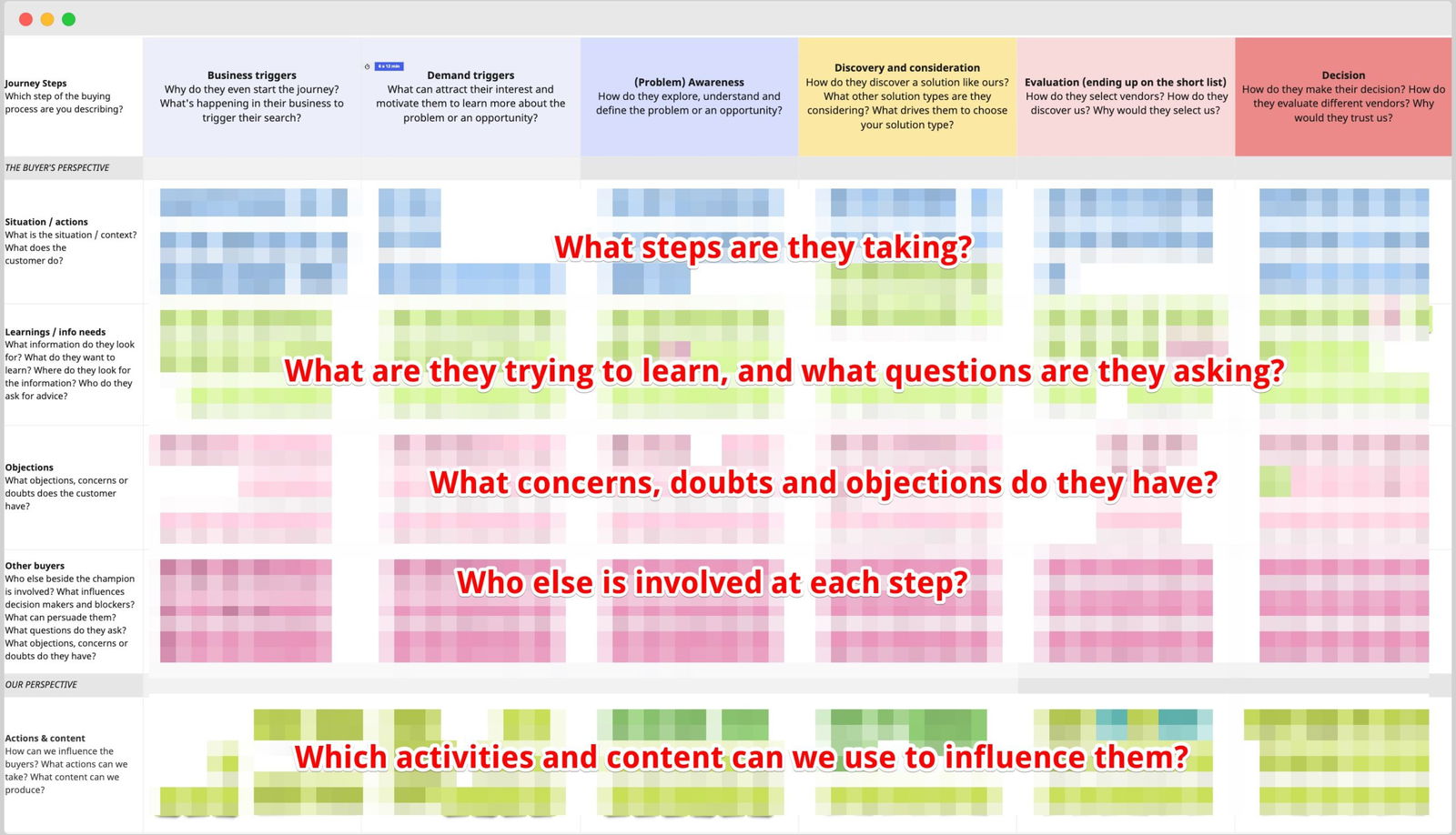
As buyers move through the stages of the buying process, you want to understand what they are trying to learn, and what questions they have.
Use these sources to collect the questions buyers have at each stage of the buying journey:
- Questions they asked via email and website (contact form, chat…)
- Questions they asked the members of your sales and CS teams
- Frequently asked questions in target communities, questions in comments of thought leaders’ posts, and social media profiles of the buying committee member of your best customers
- Customer interviews
During customer interviews, ask the following questions:
- When evaluating our solution, what were your main requirements?
- When selecting a provider like us, what else do you find important?
- What kind of information are you looking for (on the provider’s website, social media, review sites)?
- What raises red flags?
- How did you present our solution to the management team and your colleagues? What information did they ask?
- What were the most important criteria and factors that influence your purchasing decision?
- Which alternative solutions did you consider, and why did you decide not to use them?
- Why did you choose our solution?
Here is an example of informational needs that buyer have when at different stages:
- The triggering event: A painful board meeting, where the CEO of a B2B SaaS company gets critical feedback for missing the growth targets.
- Example informational needs: Why did we miss our targets? What are the common reasons for missing targets for a B2B SaaS company with an ARR of $10M?
- Follow-up meetings with the head of sales and the CMO, the journey is started to understand the bottlenecks and explore different solutions.
- Example informational needs: revenue breakdown per revenue source (recurring revenue from existing customers, deal expansion, net new revenue) and account tiers. What is the average deal size per revenue source? Breakdown and average deal size of net new revenue per deal source? Conversion rates across the funnel? Where is the biggest drop off…
- Decision is made to study ways to reduce churn and grow pipeline with enterprise segment.
- Best strategies and channels to generate enterprise leads for B2B SaaS? How to identify which accounts are ready to buy? Is intent data worth the investment?
6. For each stage of the buyer journey, identify buyer objections
The goal at this stage is to identify any critical questions, concerns or doubts that buyers have as they move through the buying process.
Here are four ways to identify the common objections:
- During the research of written or logged customer communication (in the previous step), identify any critical questions buyers are asking, as objections are often hidden behind questions
- Study lost deals in CRM, and check the most recent notes for the reasons why the deal was lost, and collect those
- Usually, the sales team will have lots of information about the common objections—and frequently, these will be well documented. In addition, the easiest way to get this information is during the buying journey workshop, where you ask the team members to individually list any critical questions, objections they get (e.g. on sticky notes or a Miro board)
- Customer research. During customer interviews, you can ask your customers:
a. What raises red flags as you evaluate a solution like ours?
b. Did you have any concerns or doubts about choosing us?
Work with the sales team to prioritize the objections, and also ask them about the ways they go about addressing them.
7. For each stage of the buyer journey, identify buyer personas involved (the buying committee members)
Most B2B companies focus their marketing and sales development effort on the decision makers. The problem with this approach is that the decision makers are usually the most difficult people to reach, and are usually not interested in the details of your solution, but more in a general category, how it fits into the overall strategic goals and processes, and the ROI.
The goal of this stage is to understand who the other members of the buying committee are, their goals, challenges, needs and evaluation criteria. This way, you can attract the attention and influence the people who are doing the research, championing your solution internally, people being asked for an opinion, or might block your deal as they perceive it is a threat or competition for internal resources or budget.
By understanding and influencing the whole buying committee you can increase the awareness and demand for your solution, generate more opportunities, and prevent losing deals that today you might be lost because you’re not aware of an internal blocker or secondary evaluation criteria.
Here are four ways to identify the common objections:
- Study the CRM, and identify all the contacts that are added to the deal, or with whom your teams have had communication with.
- Study the conversations from your CS team, and Include the people implementing and using your product, as they will likely have some influence on the deal, too.
- During the buying journey workshop, as you move through the stages, ask your sales colleagues who else was involved and what their goals, challenges and objections were.
- During customer interviews, ask your customers:
a. Who of your colleagues was involved?
b. Who did the research?
c. Who participated in the meetings? Who was asked for feedback or opinion?
d. Who signed off on the deal?
e. How did you introduce our solution and the proposal to the management?
f. What kind of information did the decision-makers request ?
j. Did you get any questions from other colleagues?
How to define actions and content for the different stages of the buyer journey
By now, you should have mapped out the different buying triggers and steps that buyers subsequently take. For each step, you should have collected the informational needs, questions and objections your buyers have as they move through the buying process.
Step #1 Define key actions and content for each stage
Invite key people from the marketing and sales team, and a subject-matter expert to a workshop. For each stage:
- Do a quick round of voting to prioritize the questions and objections that your buyers have at this stage
- For the top priority questions and objections, brainstorm the content and actions you could take to answer the questions or diffuse the objections
Start with the later stages first, as influencing buyers at that stage tends to have the best ROI in the long run (because this way, you’re plugging the leaks in your funnel, instead of pouring more water into a leaky bucket).
For example, during a decision stage, where buyers are reviewing a proposal for our ABM programs, they will have questions about results, ROI, who needs to be involved from their team, time, resources and technology stack required. Right now, each of our proposal includes:
- Example results our clients are getting from each program we’re presenting, linking to detailed case studies
- Forecast of qualified pipeline for each program, and the proposal as a whole (based on the data they shared with us)
- Overview of the recommended tech stack
- Each program has a section with frequently asked questions. For each question, we will either record a short video answer, or point to an existing LinkedIn post (for example: How quickly can you expect results on LinkedIn?)
To drive demand for the solution category and natively promote our services, we regularly publish case studies and run webinars (or run a “live case study” webinar, such as this one with we ran with a client).
And here are a few example buying journey steps in the awareness stage with content ideas and examples:
- The triggering event: A painful board meeting, where the CEO of a B2B SaaS company gets critical feedback for missing the growth targets. Example content ideas:
- A LinkedIn post, or a podcast episode about the most common reasons for missing targets for a B2B SaaS company with an ARR in the $10M-$20M range
- In follow-up meetings with the head of sales and the CMO, the journey is started to understand the bottlenecks and explore different solutions. Example content ideas:
- A LinkedIn post about analyzing revenue to identify bottlenecks and growth opportunities
- Market research: 146 B2B Execs Share: 8 Marketing Mistakes That Rob You of Revenue
- The decision is made to study ways to reduce churn and grow pipeline with enterprise segment. Example content ideas:
- A LinkedIn post about 15 ways to generate quality B2B leads in 2022
- A guest article 3 ABM Campaigns to Grow Your Pipeline in 2022 (first published as a webinar on the same topic)
Step #2 Create a Map of Informational Needs
Here is the critical mistake that companies make when planning content: they base their decisions on keyword research and come up with ideas behind closed doors, using fictive personas (like “try-hard Tammy, the suburban mother of two…”).
But the key is to identify the topics in which your buyers are genuinely interested in.
A Map of Informational Needs helps you avoid irrelevant content that gets ignored, and saves you from staring at a blank piece of paper thinking what to write about.
Map of Informational Needs is a document that summarizes all the topics, subtopics, and potential questions your buyers have as they move through the buying journey.
Here are the key sources to use when creating a map of informational needs.
1. Buyer journey
Collect all the topics, questions and objections from the buyer journey, and organize them into topics, subtopics and questions.
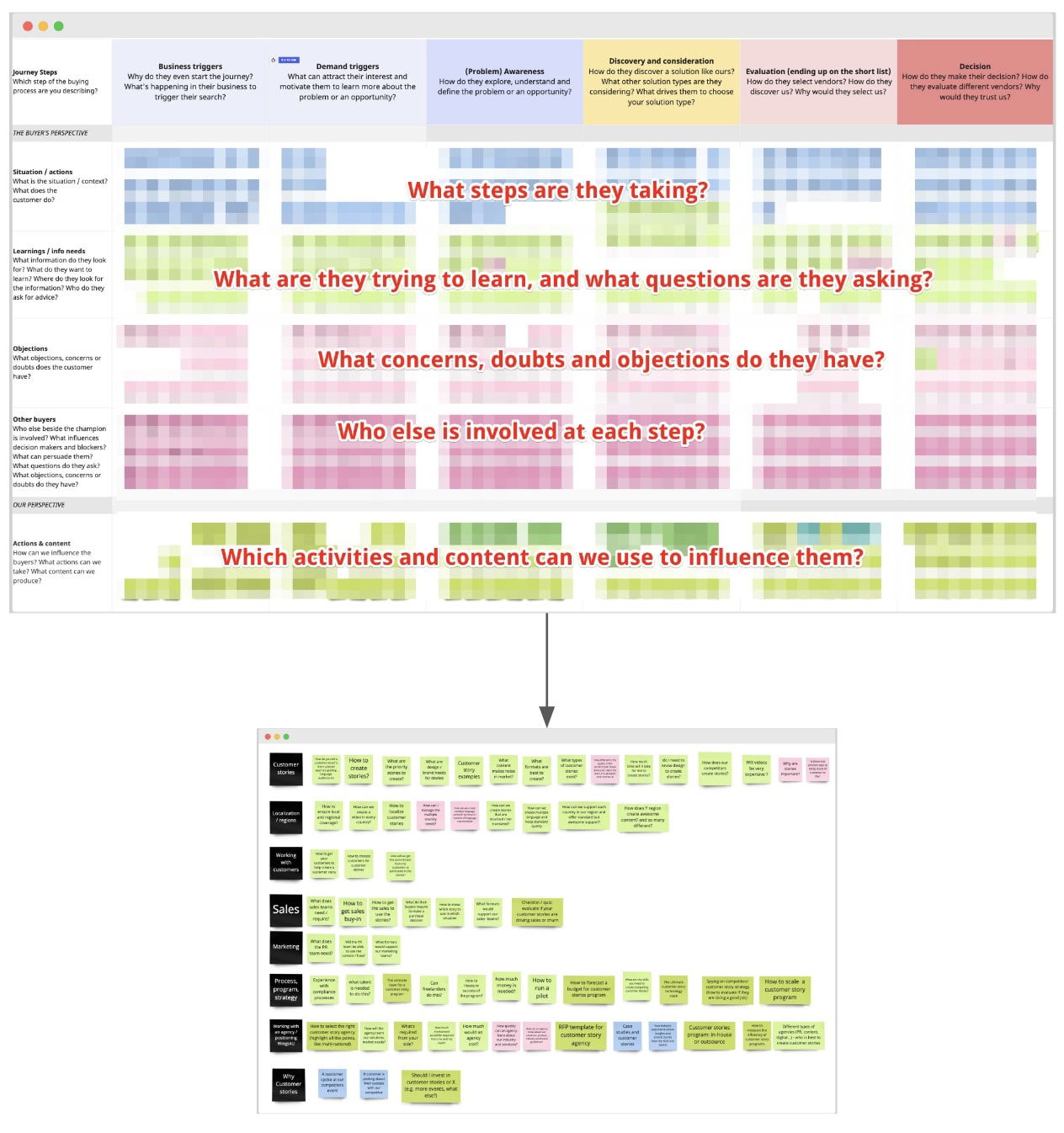
2. Customer interviews and surveys
From the customer interviews, extract the topics and questions related to triggers, goals, challenges and objections. Here is an example:
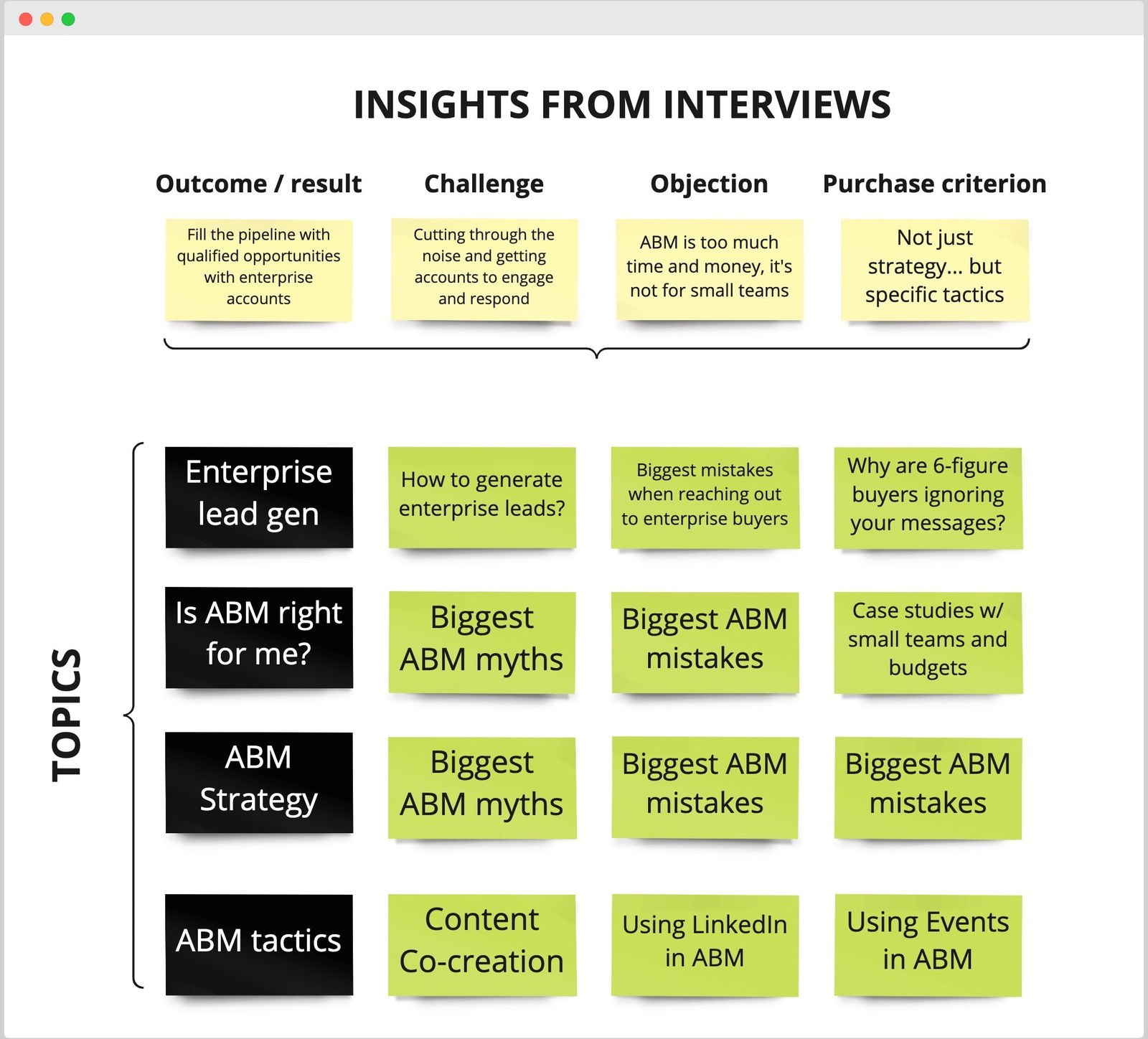
Next to that, from interviews, extract the thought leaders, events, communities, associations etc, to study in the next steps.
3. Target communities
Analyze questions target buyers ask in industry communities. For example:
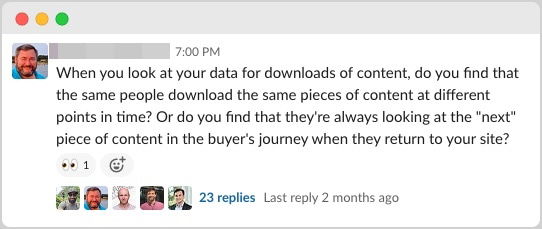
4. Events and conferences
Pour through virtual events and conferences. Identify questions, agendas, and topics being discussed.
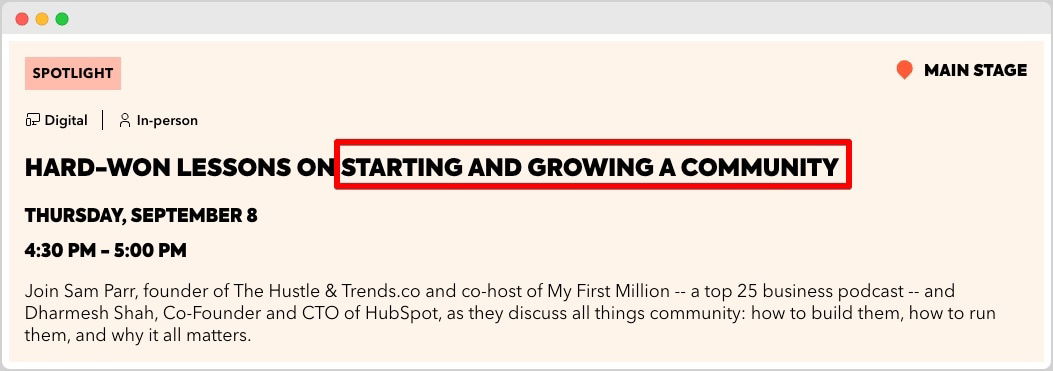
5. Thought leaders and influencers
Analyze the posts from influencers and thought leaders, and collect relevant post topics and questions that your target buyers are asking them in the comments. For example:
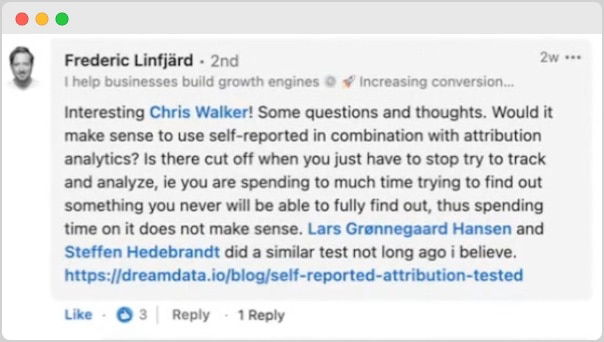
Step #3 Prioritize and plan content production
The first step is to run a content audit and identify which content you have and can use or repurpose, and which content needs to be updated or created:
- List all existing content, including all the types of content you have (videos, slides, press releases, case studies, etc)
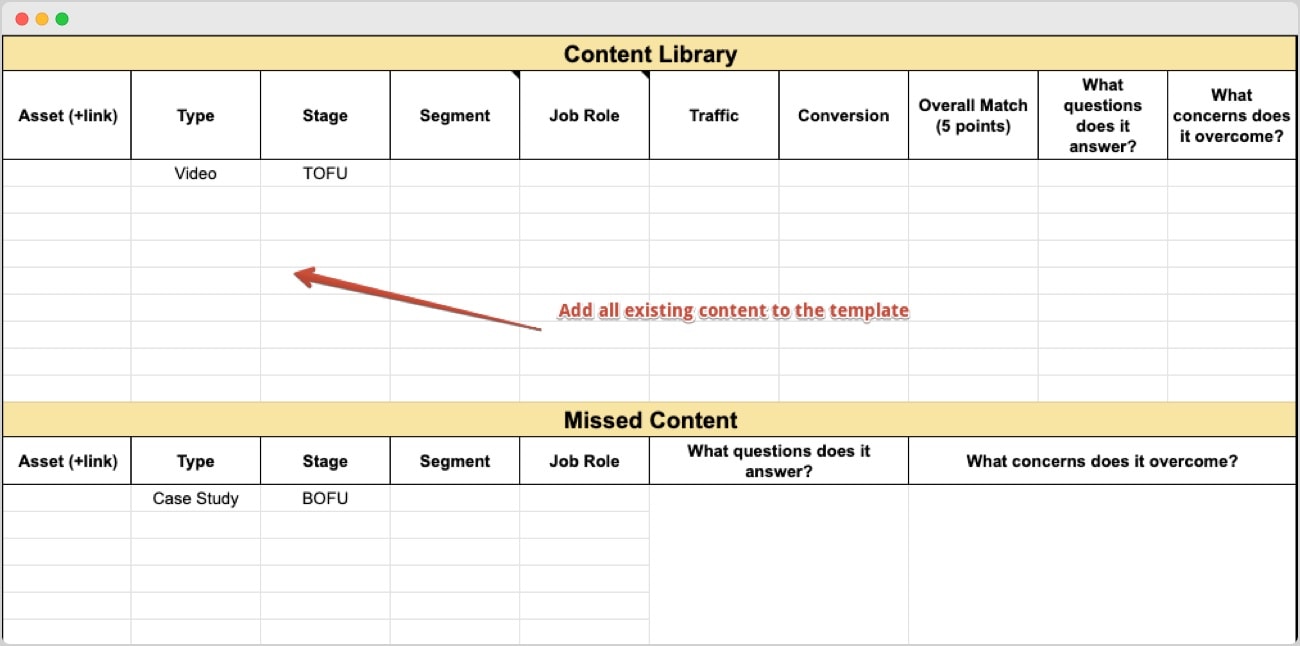
2. Evaluate existing content. Analyze traffic, conversion, overall match, what concerns it overcomes or what questions it answers
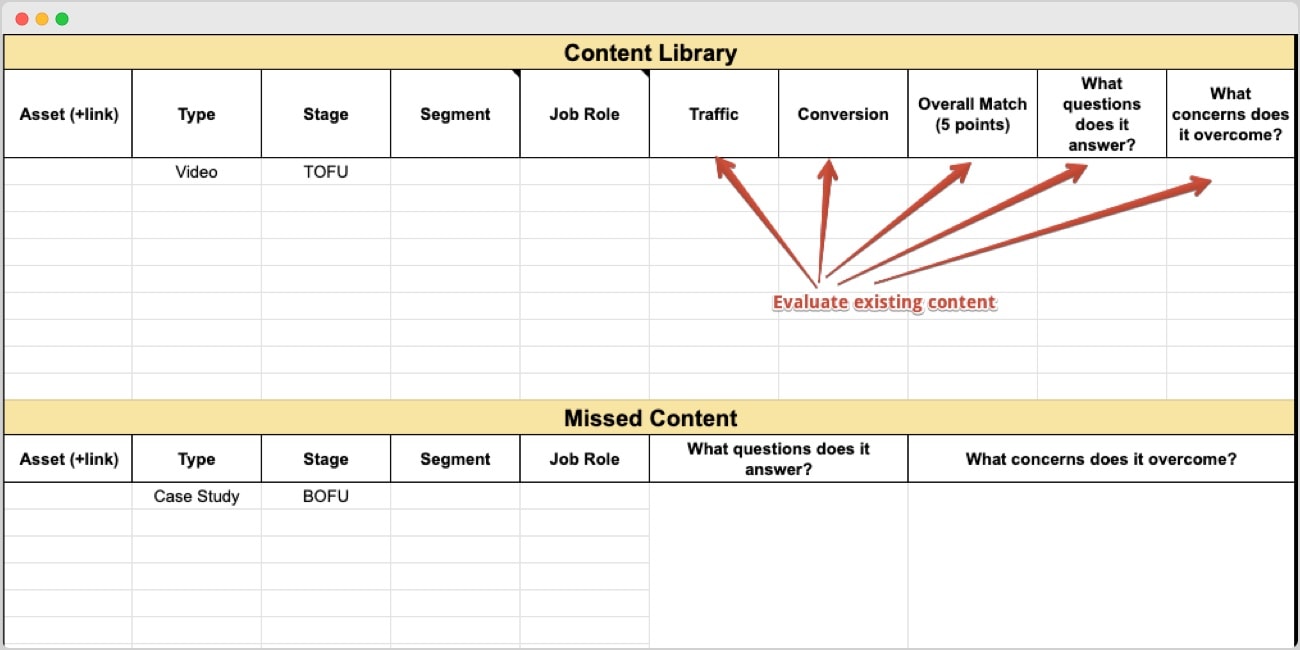
3. Add missing content. Take a look at your map of informational needs and buyer journey and add all the missing content
When you have identified the content that needs to be created or updated, assign priorities to each of the content pieces. Highest priority should be given to the bottom of funnel content.
Finally, make a list of content-related tasks.
Conclusion and next steps
The way that modern B2B buyers go about discovering, evaluating a buying high-value, complex products and services has fundamentally changed over the last decade.
The root reason why many B2B marketing programs fail, is because they’re relying on using outdated playbooks that assume a linear and transactional buying process.
This article has given you the tools to understand the modern buying journey, and to map out the triggers, steps and informational needs your best customers take when acquiring, implementation and expanding your product.
What’s next?
The end goal is to develop and implement a marketing process based on the way your best customers buy. And the first step is creating a go-to-market strategy. If you’re ready to jump in, check out our B2B Marketing Strategy Playbook, and you will:
- Define marketing activities & content that can attract the attention of target buyers, educate them, and generate demand for our product
- Develop a full-funnel marketing plan to create awareness, generate & capture demand, and generate sales opportunities with target accounts
- Get marketing & sales alignment on goals, ICP, campaigns, and leads hand-off process
- Build a unified marketing & sales report connecting all marketing activities to revenue, even if your sales cycle is long
Check out the playbook here: https://fullfunnel.io/b2b-marketing-strategy-playbook/




